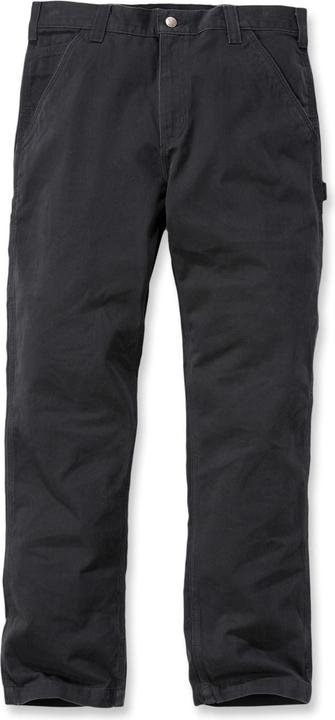
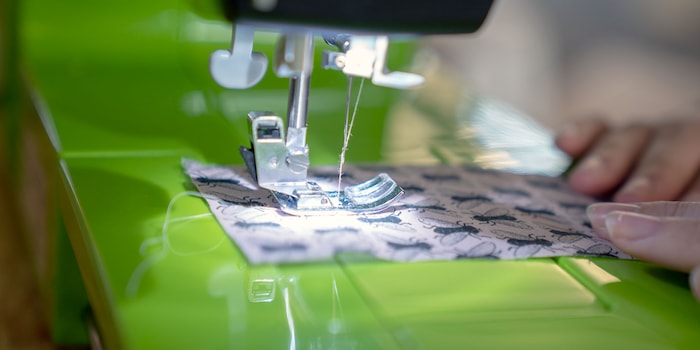
Toyota Oekaki: Anne saves a pair of trousers
This is a story about a translating French lady, a green sewing machine and a torn belt loop on a hot midday in Zurich. And a lesson on why it’s worth owning a sewing machine.
«I’m not sure about this machine», translator Anne Chapuis tells me. What many people at our workplace don’t know, Anne is training to be a fashion specialist. She also has her own label Swanne and a small collection to go with it.

Anne is sitting at our chaos table in the marketing office, the Toyota Oekaki is in front of her. The small, green sewing machine does not appeal to her because it’s made of glossy plastic. In her opinion, the design makes the machine look cheap, even though the reviews she read were good. In any case, the time has come for our fashion specialist to use the sewing machine. She put herself in this situation and there’s only one way out.
Anne gets down to business
Rewind to about 10 minutes earlier. Anne sees me walk through the office. I’m on my way to the fridge to grab a bottle of cola. What I don’t know but Anne spots right away: A belt loop on my trousers has partly come off. Frankly, I couldn’t care less. After all, these Carhartt's are my work trousers and need to go in the wash. These are the features of my trousers:
- Used to be black, now sport a copper patina
- Right knee is worn – I kneel down a lot to take photos
- Belt loops are all pretty battered, one of them has torn
I’m genuinely not bothered about any of this. I want these trousers to evolve into a beautifully ripped specimen with a post-apocalyptic charm. Minus the smell that is. Anne doesn't mind the actual concept of these pants but she can't live with the dodgy belt loop.
«How about I quickly repair them for you», she asks. Her question sounds more like a statement, so I hand the trousers over. My replacement trousers are a newer version of the same model. They’re so new that they’re still a bit tight and stuff. But they’ll be awesome over time. Why is it that trousers are the most comfortable when they look the most knackered?
Threading the needle
Anne chooses a white thread to repair my black trousers.
«It will create a nice and loud contrast», she says.
I nod, for I know absolutely nothing about sewing. She attaches a black chart to the machine that lists all the stitches the machine has to offer. There are over 50 in total – long stitches, short stitches, cross-stitches and delicate stitches. Anne goes for a strong and simple stitch. She wants the final result to look like I’ve repaired the trousers myself. The only criteria: The loop shouldn’t tear again and it’s got to look a bit used.
Anne carries out the repair with the freehand stitch feature – the highlight of this machine according to Toyota. The Oekaki – the Japanese term «お絵描き» roughly translates to «The act of drawing a picture» – does as its name suggests: decoration and patterns. Anne sets the needle speed to 1. This produces long stitches provided you have a steady hand.
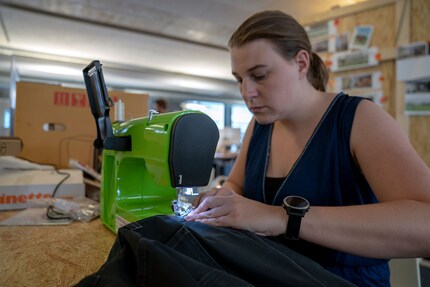
Before letting loose on my trousers, she runs a test on a random piece of fabric with a fly print. After all, the stitches on the trousers are meant to last. And if my shabby-looking trousers are repaired with rubbish stitches, I’ll have to bin them. Or I could’ve just ignored the torn loop. Whatever.
Under a minute later and my belt loop is re-attached to the trousers.
«I really don’t know how long that will last», she says, «or if you’ll be able to use the loop for a belt again.»
She stops for a moment and sighs.
«But I’m pretty sure you don’t care either way», she adds.
She’s right.
Let the fun begin
As this is a highly scientific test of a small, neon-green sewing machine – and when I say highly, I mean highly – I ask Anne for her verdict.
«Actually, the machine’s quite OK», she says.
It seems that’s all she has to say before grabbing the piece of fly fabric and asking me which stitch she should try out. Before I can reply, she’s already pressed the plus button on the display and selects number 25 – a circular pattern. Anne uses a red thread at the top and a white one at the bottom.
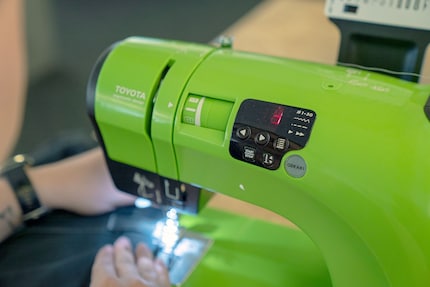
The machine fills the marketing office of our multi-million company with a soothing tuck-tuck-tuck. A circle is created on the piece of fly fabric.
«Hmmm...», she mutters.
I lower my Sony a7s, with which I’ve documented the entire process, and look at her quizzically. I think it’s dawned on her that I don’t know the first thing about sewing machines and the like.
«See those white dots on the upper thread? That means I haven’t properly adjusted the thread tension.»
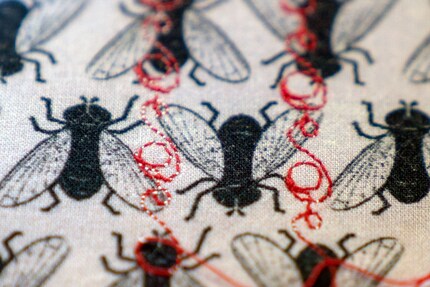
She turns the wheel that regulates thread tension and tries again. It works. Next up is stitch number 46, a type of mountain chain. Anne is playing. Clearly, she’s finding this «OK» machine a lot more fun than I thought.
«Truth be told», our sewing translator admits, «this machine is kind of fun.»
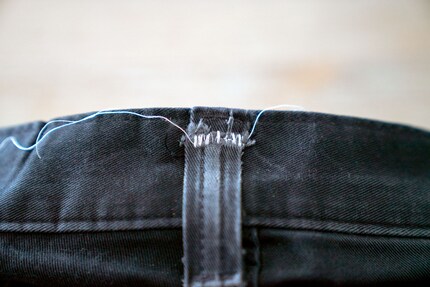
There’s not much time left for her to play around with this little green machine. After all, there are texts waiting to be translated. I take a look at my trousers with their white stitches and like them just the way they are. I sit down and write a story about a French lady with sewing skills that improved my trousers.
Journalist. Author. Hacker. A storyteller searching for boundaries, secrets and taboos – putting the world to paper. Not because I can but because I can’t not.
Interesting facts about products, behind-the-scenes looks at manufacturers and deep-dives on interesting people.
Show all